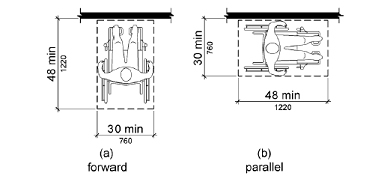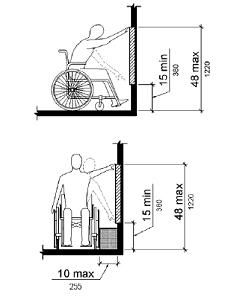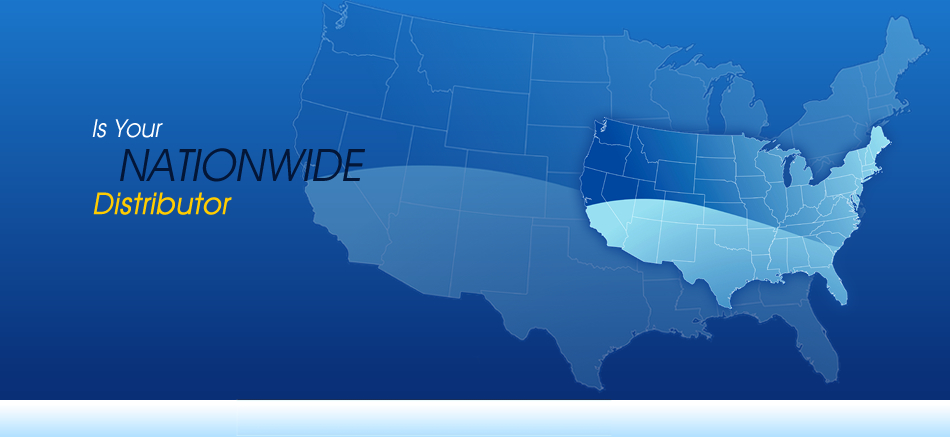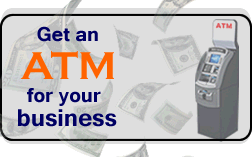ADA Compliant
The following is an overview of what all ATM Owner/Operators should know about
the 2010 ADA Standards. We believe it sums up the ADA ATM Compliancy issue
very well. The information contained within this ADA packet has been provided to
us by the various entities. These documents are not intended to be a substitute for
professional legal advice. For more information regarding the ADA and 2010
standards you may visit the Department of Justice (DOJ) website at www.ada.gov.
OVERVIEW
On July 26, 2010, on the 20th anniversary of the Americans with Disabilities Act (ADA), the Department of
Justice announced rules updating the ADA standards governing the construction and alteration of
facilities, including places of public accommodation, commercial facilities and state and local government
facilities.
The new standards adopt guidelines established by Access Board, an independent federal agency that
develops and maintains design criteria to ensure access for people with disabilities.
2010 Standards
Section 707 of the new 2010 Standards adds specific technical requirements to ATMs for
speech output, privacy, tactilely-discernible input controls, display screens, and Braille
instructions to the general accessibility requirements set out in the 1991 Standards. The
1991 Standards require ATMs to be accessible to and independently usable by persons
with visual impairments, but do not contain any technical specifications .
Adopted Guidelines
The 2010 Standards adopted the following elements, among others, from the 2004
ADA/ABA Guidelines:
-
Clear Floor or Ground Space. Clear floor space or ground space complying with section
305 of the ADA and ABA Accessibility Guidelines for Buildings and Facilities must be
provided’. This is not required at drive-up only ATMs.
1. Title III, Final Rule Amending 28 CFR Part 36, Nondiscrimination on the Basis of Disability by Public
Accommodations and in Commercial Facilities, Issued by the Department of Justice, July 2010.
2. ADA and ABA Accessibility Guidelines, published in the Federal Register July 23, 2004,
http://www.access-board.gov/ada-aba/final.cfm
-
Operable Parts. Operable parts must comply with section 309 of the ADA and
ABA Accessibility Guidelines for Buildings and Facilities”, and each operable
part must be able to be differentiated by sound or touch without activation. This is
not required at drive-up only A TMs.
ATM Compliance requirements – The DOJ ruling in regards to A TM compliance can
be broke down into two areas: (1) Accessibility and (2) Operable Parts.
1. Accessibility
Floor and Ground Services
A clear floor and ground space shall be provided for the ATM customers
(not a requirement for drive-up ATMs). Carpet pile height should not
exceed 1/2 inch maximum. In addition exposed carpet edges are required
to be fastened to the floor surface. A change in level of the floor surface
is not permitted. A clear floor and ground space is defined as being at
least 30 inches by 48 inches.

3. ADA and ABA Accessibility Guidelines, published in the Federal Register July 23, 2004,
http://www.access-board.gov/ada-aba/final.cfm
Reach Ranges
To ensure the ATM is usable in terms of height and depth, the 2010
standards detail the maximum height and depth dimensions. Regardless
of the approach of a customer who uses a wheelchair, the maximum
height a customer should be expected to reach is 48 inches and the
maximum depth a customer should be expected to reach is 10 inches. For
most A TMs these height and depth requirements are typically measured
from the floor to the top function key along the side of the display and
from the front of the ATM to the top function key along the side of the
display, respectively. That particular element (the top function key)
typically represents the extreme reach in both cases.

2. Operable Parts
-
Privacy. ATMs must provide the same degree of privacy input and output to all
individuals. -
Speech Output. ATMs must be speech enabled. All displayed information and
additional ATM functions (e.g., dispensing coupons or providing monthly statement
copies) must be accessible to and independently usable by individuals with vision
impairments. Speech shall be delivered through a mechanism that is readily available to
all users, including an industry standard connector or telephone handset. Speech can be
recorded or synthesized. - Audible tones may be permitted instead of speech for security purposes, such as
asterisks representing personal identification numbers (PINs) - Advertisements and other similar information shall not be required to be
audible unless they convey information that can be used in the transaction
being conducted - Where speech synthesis cannot be supported, dynamic alphabetic output shall
not be required to be audible - Speech shall be capable of being repeated or interrupted
- Where receipts are provided, speech output devices shall provide audible
balance inquiry information, error messages, and all other information on the
printed receipt necessary to complete or verify the transaction - The following information is not required to be presented as audible receipts:
- The location of the ATM, date and time of the transaction, customer
account number and ATM identifier; - Information on printed receipts that duplicates information available
on-screen; and - Printed copies of bank statements and checks
- Input Controls. At least one tactilely-discernible input control shall be provided for each
function. Key surfaces not on active areas of display screens must be raised above
surrounding surfaces. Where membrane keys are the only method of input, each shall
be tactilely-discernible from surrounding surfaces and adjacent keys. - Numeric Keys. Numeric keys shall be arranged in a 12-key ascending or descending
telephone keypad layout. The number 5 key shall be tactilely distinct from the other
keys. - Contrast. Function keys shall contrast visually from background surfaces. Characters
and symbols on key surfaces shall contrast visually from key surfaces. Visual contrast
shall be either light-on-dark or dark-an-light. - Tactile Symbols. Function key surfaces shall have tactile symbols as follows: Enter or
Proceed key: raised circle; Clear or Correct key: raised left arrow; Cancel key: raised
letter ex; Add Value key: raised plus sign; Decrease Value key: raised minus sign. - Visibility. The display screen shall be visible from a point located 40 inches (1015 mm)
above the center of the clear floor space in front of the machine. This does not apply to
drive-up only ATMs. - Characters. Characters displayed on the screen shall be in a sans serif font. Characters
shall be 3/16 inch (4.8 mm) high minimum based on the uppercase letter “I”. Characters
shall contrast with their background with either light characters on a dark background
or dark characters on a light background. - Braille. Braille instructions for initiating the speech mode shall be provided. {Braille
must comply with 703.3 of the ADA and ABA Accessibility Guidelines for Buildings and
Faclltties.)
4. ADA and ABA Accessibility Guidelines, published in the Federal Register July 23.2004,
http://www.access-board.gov/ada-aba/final.cfm












